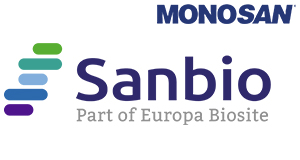Mouse anti-Immunoglobulin G, clone RWP49 (monoclonal)
Mouse anti-Immunoglobulin G, clone RWP49 (monoclonal)
Artikelnummer
SANMONX11156
Verpackungseinheit
1ml
Hersteller
Sanbio / Monosan
Verfügbarkeit:
wird geladen...
Preis wird geladen...
Clone Number: RWP49
Immunogen: Prokaryotic recombinant protein corresponding to 327 amino acids of the human IgG molecule.
Concentration: Greater than or equal to 59 mg/L
Storage buffer: Tissue culture supernatant with sodium azide
Additional info: The human immunoglobulins consist of two identical heavy chains (~50 kD) and two identical light chains, which are linked together by disulphide bonds. The light chains can be either kappa or lambda. The five immunoglobulins IgA, IgD, IgE, IgG and IgM differ in their heavy chains, and IgA and IgM differ as they can occur in polymeric forms. The heavy chain of IgG is named the gamma-chain. In humans, IgG consists of four sub classes that differ only marginally in their amino acid composition. Antibodies to IgG have been reported to be useful in the identification of plasma cells, lymphoid cells containing IgG and classifying B cell derived neoplasms. The normal B cell population is polyclonal, expressing a range of different immunoglobulins. In contrast, the majority of B cell neoplasms are characterized by the proliferation of monoclonal cells expressing one type of light chain, whereas more than one type of heavy chain can be expressed by the same cell.
Applications: IHC-P (1:200)
References: Karamchandani JR et al. American Journal of Clinical Pathology. 2012; 137: 699-711/Janeway C et al.Chapter 3. Garland Science. New York and London. 2001/Fridman W et al. FASEB Journal. 1991; 5: 2684-2690
Immunogen: Prokaryotic recombinant protein corresponding to 327 amino acids of the human IgG molecule.
Concentration: Greater than or equal to 59 mg/L
Storage buffer: Tissue culture supernatant with sodium azide
Additional info: The human immunoglobulins consist of two identical heavy chains (~50 kD) and two identical light chains, which are linked together by disulphide bonds. The light chains can be either kappa or lambda. The five immunoglobulins IgA, IgD, IgE, IgG and IgM differ in their heavy chains, and IgA and IgM differ as they can occur in polymeric forms. The heavy chain of IgG is named the gamma-chain. In humans, IgG consists of four sub classes that differ only marginally in their amino acid composition. Antibodies to IgG have been reported to be useful in the identification of plasma cells, lymphoid cells containing IgG and classifying B cell derived neoplasms. The normal B cell population is polyclonal, expressing a range of different immunoglobulins. In contrast, the majority of B cell neoplasms are characterized by the proliferation of monoclonal cells expressing one type of light chain, whereas more than one type of heavy chain can be expressed by the same cell.
Applications: IHC-P (1:200)
References: Karamchandani JR et al. American Journal of Clinical Pathology. 2012; 137: 699-711/Janeway C et al.Chapter 3. Garland Science. New York and London. 2001/Fridman W et al. FASEB Journal. 1991; 5: 2684-2690
| Artikelnummer | SANMONX11156 |
|---|---|
| Hersteller | Sanbio / Monosan |
| Hersteller Artikelnummer | MONX11156 |
| Verpackungseinheit | 1ml |
| Mengeneinheit | STK |
| Reaktivität | Human |
| Klonalität | Monoclonal |
| Methode | Immunohistochemistry (paraffin) |
| Isotyp | IgG1 |
| Wirt | Mouse |
| Konjugat | Unconjugated |
| Produktinformation (PDF) | Download |
| MSDS (PDF) |
|

 English
English







